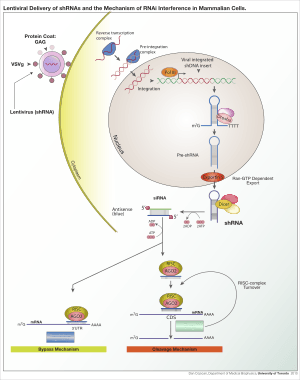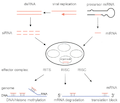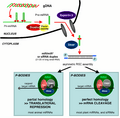RNA interference facts for kids

RNA interference (RNAi) is a process in living cells. It adjusts (moderates) the activity of their genes. RNAi molecules are a key to gene regulation. In 2006, Andrew Fire and Craig Mello shared the Nobel Prize in Physiology or Medicine for their work on RNA interference in the nematode worm Caenorhabditis elegans, published in 1998.
Two types of small RNA molecules – microRNA (miRNA) and small interfering RNA (siRNA) – do the work. These small RNAs bind to normal messenger RNA (mRNA) molecules and increase or decrease their activity. They can prevent a mRNA from producing a protein. RNA interference defends cells against foreign nucleotide sequences – viruses and transposons. Also, they control development, and gene expression in general.
The RNAi pathway is found in many eukaryotes including animals. RNAi is a valuable research tool, in cell culture and in living organisms. Synthetic dsRNA introduced into cells can suppress specific genes of interest. RNAi may be used for large-scale screens that shut down each gene to analyse cellular process or cell division. The pathway is also used as a practical tool in biotechnology and medicine.
Functions
Natural functions
The natural functions of RNA interference are:
- Immunity against foreign virus (and other) RNAs
- Upregulation of genes
- Downregulation of genes
Artificial functions
Images for kids
-
The dicer protein from Giardia intestinalis, which catalyzes the cleavage of dsRNA to siRNAs. The RNase domains are colored green, the PAZ domain yellow, the platform domain red, and the connector helix blue.
-
The stem-loop secondary structure of a pre-microRNA from Brassica oleracea.
-
small RNA Biogenesis: primary miRNAs (pri-miRNAs) are transcribed in the nucleus and fold back onto themselves as hairpins that are then trimmed in the nucleus by a microprocessor complex to form a ~60-70nt hairpin pre-RNA. This pre-miRNA is transported through the nuclear pore complex (NPC) into the cytoplasm, where Dicer further trims it to a ~20nt miRNA duplex (pre-siRNAs also enter the pathway at this step). This duplex is then loaded into Ago to form the “pre-RISC(RNA induced silencing complex)” and the passenger strand is released to form active RISC.
-
The enzyme dicer trims double stranded RNA, to form small interfering RNA or microRNA. These processed RNAs are incorporated into the RNA-induced silencing complex (RISC), which targets messenger RNA to prevent translation.
-
Illustration of the major differences between plant and animal gene silencing. Natively expressed microRNA or exogenous small interfering RNA is processed by dicer and integrated into the RISC complex, which mediates gene silencing.
-
A normal adult Drosophila fly, a common model organism used in RNAi experiments.
See also
 In Spanish: ARN interferente para niños
In Spanish: ARN interferente para niños







